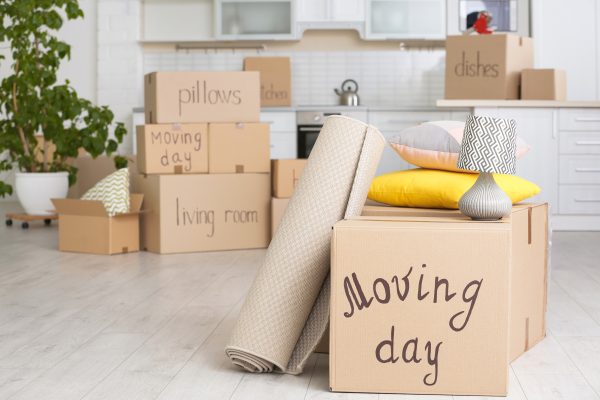Moving to a new home can be an exciting yet daunting experience. One of the most critical aspects of a successful move is packing efficiently. Knowing what to pack first can streamline the process and reduce stress. In this comprehensive guide, we will provide you with expert advice on what to pack first when moving. From when to start packing to creating a packing checklist, we’ve got you covered. Plus, we’ll highlight why it’s highly recommended to enlist the services of a professional moving company like Interior Moving Services in Rochester, NY. Let’s get started!

Timing Is Key
When it comes to packing for a move, timing is crucial. Starting early is your best bet for a smooth and stress-free experience. Ideally, you should begin packing at least six to eight weeks before your moving date. This will give you ample time to sort through your belongings and pack strategically.
Declutter Before You Pack
Before you start packing, it’s essential to declutter your home. Go through each room and decide what to keep, donate, sell, or discard. The fewer items you have to pack, the easier and cheaper your move will be.
What to Pack First
Now, let’s dive into what to pack first:
- Off-Season Items: Begin by packing items that you won’t need before your move, such as off-season clothing, holiday decorations, and sports equipment. These items are typically stored away, making them an ideal starting point.
- Rarely Used Items: Next, focus on things that you rarely use, like books, DVDs, or kitchen appliances you don’t frequently cook with. These can be packed early without disrupting your daily life.
- Out-of-Season Home Decor: If you’re moving during a different season, pack up decorations that won’t be needed until after the move, like winter coats, beach towels, or holiday decorations.
- Excess Linens: Reduce your linen closet’s contents by packing up spare bedding, towels, and linens you won’t need before moving day.
- Collectibles and Memorabilia: Items like collectibles, family heirlooms, and sentimental objects can be packed early, as they are not part of your daily routine.
Create a Packing Checklist
To ensure you don’t forget anything, create a comprehensive packing checklist. Divide it into categories based on rooms or item types. This checklist will help you stay organized and on track during the packing process.
- Room-by-Room List: List all the rooms in your house and the items in each room that need to be packed. This will serve as your master list.
- Packing Supplies: Make a separate checklist for packing supplies, such as boxes, tape, bubble wrap, and labels. Having these items on hand from the beginning will prevent delays.
- Prioritization: Once you’ve listed everything, prioritize items based on necessity. This will help you decide what to pack first and what can wait until later.
Pack Room by Room
When it’s time to start packing, tackle one room at a time. This approach keeps the process organized and manageable.
- Labeling: As you pack, label each box with its contents and the room it belongs to. Clear labeling will make unpacking a breeze.
- Essentials Box: Pack a separate “essentials” box for each member of the household. This box should contain items you’ll need immediately upon arriving at your new home, such as toiletries, a change of clothes, and important documents.
Kitchen Essentials
The kitchen is often one of the most challenging rooms to pack due to its abundance of fragile items. Start by packing the dishes, glassware, and cookware you use least frequently. Leave out only the essentials, like a few plates, glasses, and utensils. Remember to wrap fragile items with packing paper or bubble wrap and use dividers for dishes to prevent breakage.
- Non-Perishable Foods: Sort through your pantry and cabinets and pack non-perishable items that you won’t need before the move. Consider donating any unopened, non-expired food to a local food bank.
- Appliances: If you have small kitchen appliances that you rarely use, such as a blender or toaster oven, pack them early. Ensure they are clean and dry before packing.
Clothing and Personal Items
Clothing can be a time-consuming part of the packing process. Begin with out-of-season clothing and items you rarely wear. Fold clothes neatly and pack them in sturdy boxes or vacuum-sealed bags to save space.
- Seasonal Gear: If you have sports equipment or seasonal clothing like ski gear or swimsuits, pack them early. These items are often stored away, so they won’t be missed until the move.
- Shoes and Accessories: Pack shoes and accessories that you don’t use regularly. Keep a few pairs of essential shoes and accessories accessible for daily use.
Home Office and Electronics
If you work from home or have a home office, start packing non-essential office supplies and electronics. Be sure to label cords and cables for easy reassembly later.
- Important Documents: Safeguard important documents like passports, birth certificates, and financial records. It’s wise to keep these with you rather than packing them in a moving truck.
Furniture and Large Items
Large furniture pieces, such as bookshelves, side tables, and extra chairs, can be packed closer to your moving date. Disassemble any furniture that can be broken down, keeping screws and hardware organized in labeled bags.
Artwork and Valuables
Artwork, antiques, and valuable items should be packed with extra care. Consider hiring professional packers for these delicate items to ensure they are well-protected during transit.
Last-Minute Essentials
In the days leading up to your move, focus on packing items you use daily. These should go into clearly labeled boxes, making it easy to locate what you need upon arrival at your new home.
- Toiletries: Pack toiletries, medicines, and personal hygiene items you use daily. Remember to keep a set of clean towels and bedding accessible for your last night in your old home and the first night in your new one.
- Electronics: Disconnect and pack essential electronics, such as your TV, computer, and chargers, in the days just before your move.
- Clothing: As moving day approaches, pack your remaining clothing, ensuring everything is clean and well-organized.
Why Choose Interior Moving Services
While packing is a crucial aspect of any move, enlisting the services of a professional moving company like Interior Moving Services can make the entire process smoother and more efficient. Here’s why:
- Expertise: Our team of experienced movers knows the ins and outs of packing and moving. We can handle your belongings with care and ensure they arrive at your new home intact.
- Efficiency: We have the right equipment and packing materials to pack and transport your items safely and efficiently.
- Time-Saving: Hiring professionals allows you to focus on other aspects of your move, such as settling into your new home.
- Reduced Stress: We take the stress out of moving, ensuring that everything goes according to plan.
- Insurance Coverage: With Interior Moving Services, your belongings are protected by insurance, providing peace of mind during your move.
Learn more about our services here: https://interiormoving.com/
Related Posts

How to Lower the Cost of Your Move in Pittsford, NY

How to Prepare for a Smooth Moving Day in Pittsford, NY

